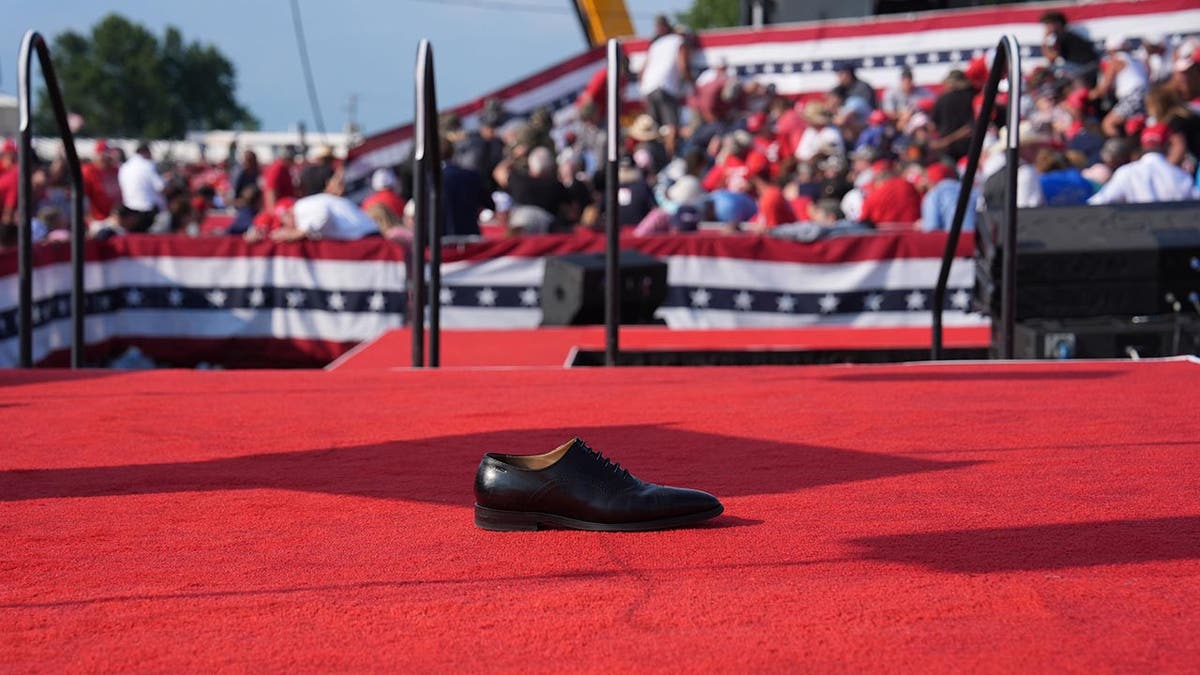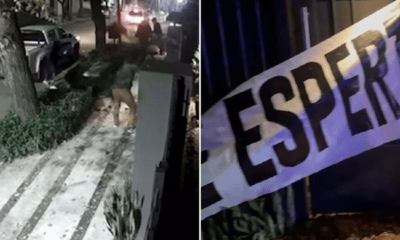INTERNACIONAL
Race against time: How Congress barely made July 4 deadline on ‘big, beautiful bill’

NEWYou can now listen to Fox News articles!
Football and basketball coaches are experts in clock management.
So are lawmakers.
Coaches are adept at either burning or saving just enough time on the clock to execute a play – or prevent the other team from doing so.
Congressional clock management is very different.
TRUMP $3.3T MEGABILL SETS HOUSE RECORD FOR LONGEST VOTE IN HISTORY
Whatever lawmakers say they will do – it will always take them a profoundly longer period of time in which to do it.
That’s why the temporal politics of passing President Donald Trump’s «big, beautiful bill» overwhelmed everyone who works on Capitol Hill over the past few weeks.
That ranges from the lawmakers themselves to the aides, journalists, Capitol custodians and U.S. Capitol Police officers.
To wit:
Congressional Republicans have churned through variations of frameworks and iterations of the big, beautiful bill since February. But things finally got serious when the House adopted its formal version of the package on May 22, beating the Memorial Day goal by four days.
There was chatter that the Senate would tackle the House’s package the week of June 9. Then that fell to the week of June 15. The idea was that the Senate would process its version of the bill that week and then allow the House to sync up during the week of June 22.
Then those hopes were dashed.
That’s to say nothing of the Senate at least voting to proceed to even start debate at the very end of the week of June 15.
Here’s what really happened. And it underscores just how protracted the process can be on Capitol Hill, especially with a very complicated and controversial piece of legislation.
On Monday, June 23, Republican senators talked about taking a procedural vote to launch debate on the big, beautiful bill as early as Wednesday or Thursday, June 25 or 26. Such a vote would require just 51 yeas. But the bill wasn’t ready. Republicans were still crafting and drafting the bill to comport with Senate budget rules. The GOP also aimed to write the legislation in a fashion to court 51 yeas to crack the procedural hurdle and formally start debate.
Midweek came and the Senate never took a procedural vote. Sens. Ron Johnson, R-Wis., and Thom Tillis, R-N.C., opposed starting debate on a bill that was not complete.
So midweek morphed into the weekend, and when the Senate convened on Saturday, June 28, Fox News was told the chamber would take a procedural vote to begin debate around 4 p.m. ET.
SENATE REPUBLICANS RAM TRUMP’S ‘BIG, BEAUTIFUL BILL’ THROUGH KEY TEST VOTE
Well, you guessed it.
The Senate did not trigger that vote until 7:31 p.m. Saturday. And the 15-minute vote turned into a three-hour and 38-minute affair. The Senate closed the vote at 11:09 p.m.
Saturday – with Vice President JD Vance nearby in case his services were necessary to break a tie.
They were not.
At least not on the dais.
But Vance played a pivotal role in negotiating with Johnson, Sen. Rick Scott, R-Fla., and others to greenlight the Senate starting on the bill.
However, Senate Minority Leader Chuck Schumer, D-N.Y., then compelled Senate clerks to read the entire 940-page bill out loud from the dais. That enterprise consumed just under 16 hours of floor time. The clerks – their voices cracking and hoarse – concluded a few minutes after 3 p.m. on Sunday. This marked the first time a senator required the clerks to verbally read a bill before the Senate since 2021.
So, once the clerks concluded their oratory, it was believed that the Senate might go all night with its marathon voting session – known as a «vote-a-rama» – and try to finish the bill sometime by dawn Monday.
But this is Congress time.
Senators didn’t even begin the vote-a-rama until 9:40 am Monday. Twelve hours later, Senate Majority Leader John Thune, R-S.D., suggested it was time to «start figuring out» a final group of amendments that were necessary to conclude the bill.
Some groaned at that notion. One senator told Fox News that 12 hours later was a little late in the game to «start figuring out» something of that magnitude.
The Senate then toiled throughout the night Monday and into Tuesday. Thune and the GOP leadership finally cut a deal with Sen. Lisa Murkowski, R-Alaska, on rural hospitals to marshal her vote. The Senate approved the bill late Tuesday morning after an all-night session. Vance was back to break the tie in what is called a «Van Halen» vote. The tally was 50-50 since three GOP senators defected. But Vance’s vote in favor made the roll call «51-50.»
For those who are uninitiated in the Van Halen discography, «5150» was Van Halen’s first album with new lead singer Sammy Hagar, supplanting David Lee Roth. It went to No. 1 on the Billboard charts.
Then, it was on to the House.
HOUSE ADVANCES TRUMP’S MASSIVE AGENDA BILL AFTER FREEDOM CAUCUS CAVES
The House Rules Committee serves as a gateway for legislation to head to the floor. It convened a meeting early Tuesday afternoon. The Senate would soon send its revamped version of the big, beautiful bill across the Capitol Dome for the House to align. The Rules Committee then proceeded to meet until around 1 a.m. Wednesday, prepping the bill for the floor.
That meant the House could vote by late Wednesday afternoon.
But there was a problem.
House GOP leaders discovered what they termed a «technical error» in the rule. The entire House must first approve the rule before debating legislation on the floor. So the House needed to vote on the fix first. That vote started early Wednesday afternoon – and continued for another seven hours and 31 minutes. That established a record for the longest roll call vote in House history, topping a vote of seven hours and 21 minutes in 2021.
Some Republicans weren’t at the Capitol. But they held the vote open to buy time to work on skeptical GOP members who may be holdouts.
And around 9:30 p.m. Wednesday, House Speaker Mike Johnson, R-La., decided to double-dog dare anyone who was against the bill to put their voting card where their mouth was. Republican leaders closed the «technical correction» vote and proceeded to a vote on the «rule.» If the House adopted the rule, it could formally debate the bill. The House was stuck if its members failed to approve the rule.
The tally board behind the dais in the House chamber populated relatively quickly. All 216 Democrats said no There were also four GOP no votes – and several who refused to vote yes. Republicans could only lose three votes and still pass the rule. Rep. Thomas Massie, R-Ky., was a yes on the rule – even though he opposed the bill. He then switched to no as the vote dragged on. However, Massie ultimately supported the rule in the end.
HAKEEM JEFFRIES BREAKS KEVIN MCCARTHY RECORD WHILE STALLING TRUMP’S ‘BIG, BEAUTIFUL BILL’
Reps. Victoria Spartz, R-Ind., Keith Self, R-Texas, Andrew Clyde, R-Ga., and Brian Fitzpatrick, R-Pa., were no votes throughout the vote. But around 1 a.m., there was movement. The holdouts and some of those who voted no met with Johnson and other GOP leaders. That seemed to pry loose the votes of the holdouts and opponents – except Fitzpatrick.
But there was a problem.
Rep. Scott Perry, R-Pa. – who had not voted – drove home to Pennsylvania. So everyone at the Capitol patiently waited for Perry to return. He did around 3:30 a.m. Thursday. Everyone but Fitzpatrick voted as a bloc in favor of the rule. The House had the votes to begin debate on the rule.
It looked as though the House might vote around daybreak on the actual bill itself.
But the office of House Minority Leader Hakeem Jeffries, D-N.Y., had told Fox News on Wednesday that Jeffries intended to speak for an hour or so at the end of debate. There’s a custom in the House where top leaders of both parties are yielded «a minute» to speak on the floor. But this is a «magic minute.» As a courtesy to those leaders, they speak as long as they want.
Jeffries began speaking just before 5 a.m. Thursday – and finally concluded eight hours and 45 minutes later just after 1:30 p.m. ET Thursday. Jeffries shattered the mark of eight hours and 32 minutes established by House Speaker Kevin McCarthy, R-Calif., in 2021. McCarthy set the record as minority leader.
So those House members hoping to hop an early morning flight and get home for July 4 would have to wait.
CLICK HERE TO GET THE FOX NEWS APP
Mike Johnson didn’t speak nearly as long as Jeffries. But he did observe that the late President Ronald Reagan once said that no speech should run longer than 20 minutes.
Johnson spoke for 23 minutes.
And then the House voted, finally passing the bill 218-214 at 2:31 p.m. Thursday. Fitzpatrick and Massie were the only GOP noes.
It is said that we never have enough time in life. And if you work on Capitol Hill, you’ll probably have even less thanks to congressional clock management.
INTERNACIONAL
El día que Londres se convirtió en una ciudad fantasma: actos a 20 años de los atentados terroristas del «7 de julio»

El silencio del miedo
Veinte años después
El recuerdo de las víctimas
El estigma de la comunidad musulmana
Delitos de odio y asesinatos injustos
La cohesión social
INTERNACIONAL
Journalist who refused to duck during Trump assassination attempt reflects on Butler rally in new book

NEWYou can now listen to Fox News articles!
Salena Zito, a veteran political reporter with more than 20 years of storytelling experience, is telling her own story in her book, «Butler: The Untold Story of the Near Assassination of Donald Trump and the Fight for America’s Heartland.»
Zito’s novel, released Tuesday, takes readers back to July 13, 2024, when a young shooter unleashed gunfire into the crowd at President Donald Trump’s rally in Butler, Pennsylvania.
«I didn’t get down,» Zito told Fox News Digital in an exclusive interview ahead of the release. «There was this inner voice that told me, ‘You have a job to do, continue doing it.’»
When 20-year-old Thomas Matthew Crooks began firing toward Trump, Zito found herself in the Secret Service’s secure perimeter, right by the stage where Trump was delivering his remarks.
FOX NATION REVEALS NEVER-BEFORE-SEEN FOOTAGE FROM TRUMP ASSASSINATION ATTEMPT IN BUTLER
President Donald Trump defiantly raises his fist after an attempted assassin’s bullet grazed his ear during a rally in Butler, Pennsylvania, on July 13, 2024. (AP Photo/Evan Vucci)
«Time has these layers that happen,» Zito said. «It’s not remembering them. It’s experiencing them. It’s this interesting thing that happens. I see a sea of navy blue suits immediately surround him. Then, I hear the second four shots. I still didn’t get down.»
PHOTOGRAPHER WINS PULITZER FOR ICONIC PHOTO OF BULLET SPEEDING BY TRUMP’S HEAD DURING ASSASSINATION ATTEMPT
As a gun owner, Zito recognized the sound of the gunshots right away. But as a journalist, she quickly began to commit the historic moment to memory as it was unfolding.
In an interview with Fox News Digital, Zito described the scene she saw first-hand, that was caught on video by the network pool camera and watched across the world.
Just over eight minutes into Trump’s speech, Zito was standing in the «buffer» with her daughter, her son-in-law and a Trump campaign aide, Michel Picard. It was Picard who finally brought Zito to the ground.
«Michel Picard takes me down and lies on top of me and covers me,» Zito explained. «This young man didn’t have to do this. He will always be a hero in my heart. He lies on the top of my daughter. My son-in-law has already taken my daughter down.»

A shoe is left on stage after then-former President Donald Trump was assisted offstage during a campaign rally at Butler Farm Show Inc. on Saturday, July 13, 2024 in Butler, Pa. (Jabin Botsford/The Washington Post via Getty Images)
Zito said, even from that vantage point, she could still see and hear the situation unfolding as Trump shouted out for his shoes, someone called out for a medic and a woman screamed.
«I had my recorder on my phone because I thought I was going to be recording the rally, his speech. I wanted to make sure I got the nuance. I always do that. I could see, and I could hear everything that was happening.»
She said Trump was saying, «USA,» from the ground as the crowd began to chant. When the Secret Service helped Trump onto his feet, he shouted, «Fight! Fight! Fight,» Zito said she saw a different side of Trump, which is revealed in her book.
The journalist, who is a political reporter for the Washington Examiner, is a special contributor for the Washington Post and has been a columnist for the New York Post, said Trump must have called her seven times in the 24 hours after the shooting.

Members of the crowd duck under chairs after then-former President Donald Trump was assisted offstage during a campaign rally at Butler Farm Show Inc. on Saturday, July 13, 2024 in Butler, Pa. (Jabin Botsford/The Washington Post via Getty Images)
Zito was slated to interview Trump ahead of his rally in Butler, but such is the case with presidential campaign schedules, the interview time kept slipping. Zito was planning to fly with Trump to Bedminster, N.J., to interview him after the rally.
Trump recovered from his near assassination with little more than a bullet graze to the ear, thanks to the immigration chart he was turning his head to face. One rally attendee, firefighter Corey Comperatore, was killed, and two others were critically injured by Crooks’ gunshots.
Comperatore shielded his wife and daughters from the shots, saving his family. Trump honored their family when he returned to Butler to finish the rally later that year.
«This book is for everyone,» Zito told Fox News Digital. «First of all, it was a witness to history. And it’s told in a way that is very conversational and told in way that’s very real and authentic. I tell the story exactly the way that it happened.»
CLICK HERE TO GET THE FOX NEWS APP
«But it’s also a book about understanding why place and rootedness [are] so important in American politics. There have been very few Republicans or Democrats that have understood that. It is part of America’s experience, no matter what happens next, that there’s a light shining on it, so that you understand people better.»
INTERNACIONAL
Mamonas Assassinas, la banda que revolucionó Brasil en solo 9 meses y fue marcada por la tragedia

Mamonas Assassinas conquistó rápidamente la escena musical brasileña con una propuesta basada en el humor irreverente y un estilo osado. Considerados un fenómeno del rock alternativo, su trayectoria fue breve pero intensa. Conformaron la banda en 1995 y consiguieron un impresionante éxito nacional con su único álbum, que superó los 3 millones de copias vendidas.
Sin embargo, la historia del grupo llegó a un abrupto final a los nueve meses de su creación, cuando un accidente aéreo se llevó la vida de todos sus integrantes en 1996. Pese al trágico desenlace, permanecen en la memoria colectiva como un referente insustituible de la música brasileña de los noventa.
La historia de la banda comenzó en 1990, cuando cinco jóvenes se unieron para ejecutar una de sus pasiones: la música, que combinaron con humor. Así fue como Dihno (vocalista), Bento Hinoto (guitarrista), Samuel Reoli (bajista), Júlio Rasec (tecladista) y Sérgio Reoli (baterista) conformaron Mamonas Assassinas.
El grupo se caracterizaba por fusionar géneros como el rock, pop, funk y música brasileña. Los jóvenes crearon un sonido único y pegadizo, pero, más allá de estas características, sus letras sarcásticas y su energía los hicieron destacar.
En 1995, lanzaron su primer álbum de estudio, titulado Mamonas Assassinas. El disco se consolidó con gran éxito en Brasil. Canciones como “Vira-Vira”, “Pelados em Santos” y “Robocop Gay” se posicionaron con fuerza en radios y programas televisivos.
Según consignó la revista Rolling Stone, en Argentina, Mamonas Assassinas fue un grupo de culto. Sus canciones, coreografías y humor habían atravesado la frontera y llegado a países vecinos, donde comenzaban a corear sus melodías.
La carrera de la banda fue breve. En marzo de 1996, a tan solo nueve meses de su lanzamiento en el mundo de la música, los jóvenes abordaron un avión privado con destino a Guarulhos, destino al que nunca llegarían. De acuerdo con CNN Brasil, durante el vuelo, la aeronave se estrelló en la Serra da Cantareira y murieron todos los pasajeros.

Horas antes del accidente que acabó con la vida de los miembros de Mamonas Assassinas, uno de ellos dejó registrada una escalofriante premonición. Según reveló la revista Veja, Júlio Rasec, conocido por el tono rojizo-anaranjado de su cabello y su papel como tecladista del grupo, acudió a la peluquería dirigida por su amigo Nelson de Lima antes del siniestro.
En ese encuentro, quedó grabado un video donde Rasec mencionó la posibilidad de una tragedia inminente. Lima le preguntó sobre el viaje del grupo, en el que darían una serie de conciertos, y el artista respondió: “No sé, anoche soñé con algo… Parecía que el avión se iba a estrellar. No sé. No sé qué significa eso”. El registro se convirtió en parte del legado que acompaña el mito de la banda.

Los informes iniciales revelaron que hubo una maniobra equivocada por parte del piloto, Jorge Germano Martins. No obstante, el avance de la investigación identificó otros factores, como las condiciones climáticas y la fatiga de la tripulación.
Según el informe final, el piloto habría estado agotado. Martins había superado el límite máximo de horas de vuelo permitidas. En total, voló durante 16 horas y 30 minutos, cuando el máximo autorizado era de 11 horas.
A más de 30 años del trágico suceso, el legado de la banda continúa. Según datos recogidos por CNN, en Spotify, las canciones tienen más de 50 millones de reproducciones. Además, más del 66% de los usuarios de la plataforma escucha a la banda. Las tres ciudades que más reproducen su música son São Paulo, Belo Horizonte y Río de Janeiro.

El 28 de junio de 2024, la plataforma Max lanzó la biopic de la banda, titulada Nada es imposible. La película, protagonizada por Ruy Brissac, Rhener Freitas, Adriano Tunes, Robson Lima, Beto Hinoto, Fefe Shneider y Guta Ruiz, entre otros, sigue el viaje de los músicos de Guarulhos, su ciudad de origen, hasta alcanzar un éxito que sigue vigente.
El filme fue dirigido por Edson Spinello, producido por Total Entertainment, coproducido por Mamonas Produções y Claro, y distribuido por Imagem Filmes.
A más de tres décadas de su desaparición, la figura de Mamonas Assassinas aún genera interés en nuevas producciones, investigaciones y testimonios que reconstruyen su historia desde distintos ángulos. Su corta existencia inspira relatos y homenajes que amplían el entendimiento de su lugar en la cultura brasileña y el modo en que conectaron, en tan poco tiempo, con una audiencia masiva y diversa.
-
POLITICA2 días ago
Para La Libertad Avanza el acuerdo con PRO está encaminado, pero aún hay mutua desconfianza
-
ECONOMIA12 horas ago
Chau Vialidad: anticipan una pelea por la financiación de 9.000 kilómetros de rutas
-
POLITICA3 días ago
🔴URGENTE – La Justicia liberó a tres militantes kirchneristas acusados en la causa por los desmanes en la casa de Espert




























